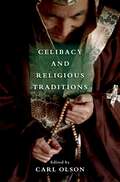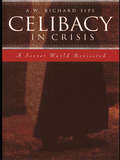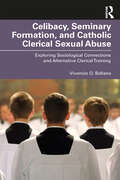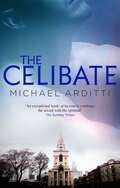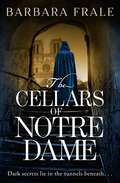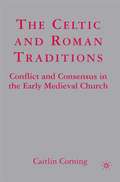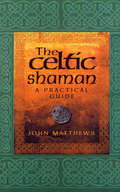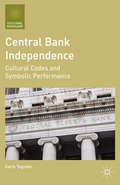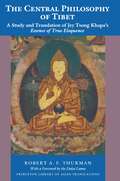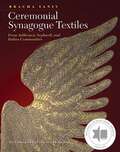- Table View
- List View
Celibacy and Religious Traditions
by Carl OlsonIf sexuality is inherently social, the same thing can be said about celibacy. An understanding of celibacy, argues Carl Olson, can be a useful way to view the significance of the human body within a social context. The purpose of this book is to examine how the practice of celibacy differs cross-culturally as well as historically within a particular religious tradition. The essays (all previously unpublished) will demonstrate that celibacy is a complex religious phenomenon. The control of sexual desire can be used to divorce oneself from a basic human biological drive, to separate oneself from what is perceived as impure, or to distance oneself from a transient world. Within different religious traditions there can be found the practice of temporary celibacy, commitment to long-term permanent celibacy, and outright condemnations of it. By maintaining a state of virginity, members of some religious traditions imitate divine models; other traditions do not admit the possibility of emulating such paradigms. Whether or not a religious tradition encourages or discourages it, the practice of celibacy gives us insight into its worldview, social values, gender relations, ethics, religious roles, and understanding of the physical body. Celibacy can contribute to the creation of a certain status and play a role in the construction of identity, while serving as a source of charisma. In some religious traditions, it is possible to renounce sex and gain sacred status and economic support from society. Each essay in the collection will be written by an expert in a particular religious tradition. Each will address such questions as: Why do some members of a religious community decide to maintain a celibate style of religious life? Is celibacy a prerequisite for religious office or status? Are there different contexts within a given religious tradition for the practice of celibacy? What does the choice of celibacy tell us about the human body in a particular religious culture? What is the symbolic significance of celibacy? What is its connection to the acquisition of power? What are its physical or spiritual benefits? The first collection of its kind, this book will be a valuable resource for courses in world religions, as well as a contribution to our understanding of this very widespread but puzzling human phenomenon.
Celibacy and Religious Traditions
by Carl OlsonIf sexuality is inherently social, the same thing can be said about celibacy. An understanding of celibacy, argues Carl Olson, can be a useful way to view the significance of the human body within a social context. The purpose of this book is to examine how the practice of celibacy differs cross-culturally as well as historically within a particular religious tradition. The essays (all previously unpublished) will demonstrate that celibacy is a complex religious phenomenon. The control of sexual desire can be used to divorce oneself from a basic human biological drive, to separate oneself from what is perceived as impure, or to distance oneself from a transient world. Within different religious traditions there can be found the practice of temporary celibacy, commitment to long-term permanent celibacy, and outright condemnations of it. By maintaining a state of virginity, members of some religious traditions imitate divine models; other traditions do not admit the possibility of emulating such paradigms. Whether or not a religious tradition encourages or discourages it, the practice of celibacy gives us insight into its worldview, social values, gender relations, ethics, religious roles, and understanding of the physical body. Celibacy can contribute to the creation of a certain status and play a role in the construction of identity, while serving as a source of charisma. In some religious traditions, it is possible to renounce sex and gain sacred status and economic support from society. Each essay in the collection will be written by an expert in a particular religious tradition. Each will address such questions as: Why do some members of a religious community decide to maintain a celibate style of religious life? Is celibacy a prerequisite for religious office or status? Are there different contexts within a given religious tradition for the practice of celibacy? What does the choice of celibacy tell us about the human body in a particular religious culture? What is the symbolic significance of celibacy? What is its connection to the acquisition of power? What are its physical or spiritual benefits? The first collection of its kind, this book will be a valuable resource for courses in world religions, as well as a contribution to our understanding of this very widespread but puzzling human phenomenon.
Celibacy in Crisis: A Secret World Revisited
by A.W. Richard SipeIn the midst of the worst crisis the Catholic Church has seen in almost 500 years, this book challenges Catholic authorities to renew, rethink, or reform the long-standing institution of celibacy.
Celibacy in Crisis: A Secret World Revisited
by A.W. Richard SipeIn the midst of the worst crisis the Catholic Church has seen in almost 500 years, this book challenges Catholic authorities to renew, rethink, or reform the long-standing institution of celibacy.
Celibacy, Seminary Formation, and Catholic Clerical Sexual Abuse: Exploring Sociological Connections and Alternative Clerical Training (Routledge Studies in the Sociology of Religion)
by Vivencio O. BallanoDoes the current celibate, semi-monastic, and all-male seminary formation contribute to the persistence of clerical sexual abuse in the Roman Catholic Church?Applying sociological theories on socialization, total institutions, and social resistance as the primary conceptual framework, and drawing on secondary literature, media reports, the author’s experience, interviews, and Church documents, this book argues that the Catholic Church’s institution of the celibate seminary formation as the only mode of clerical training for Catholic priests has resulted in negative unintended consequences to human formation such as the suspension of normal human socialization in society, psychosexual immaturity, and weak social control against clerical sexual abuse. The author thus contends that celibate training, while suitable for those who do live in religious or monastic communities, is inappropriate for those who are obliged to live alone and work in parishes. As such, an alternative model for diocesan clerical formation is advanced.A fresh look at the aptness – and effects – of celibate formation for diocesan clergy, this volume is the first to relate the persistence of Catholic clerical sexual abuse to celibate seminary formation, exploring the structural links between the two using sociological arguments and proposing an apprenticeship-based model of formation, which has numerous advantages as a form of clerical training. It will therefore appeal to scholars and students of religion, sociology, and theology, as well as those involved with seminary formation.
Celibacy, Seminary Formation, and Catholic Clerical Sexual Abuse: Exploring Sociological Connections and Alternative Clerical Training (Routledge Studies in the Sociology of Religion)
by Vivencio O. BallanoDoes the current celibate, semi-monastic, and all-male seminary formation contribute to the persistence of clerical sexual abuse in the Roman Catholic Church?Applying sociological theories on socialization, total institutions, and social resistance as the primary conceptual framework, and drawing on secondary literature, media reports, the author’s experience, interviews, and Church documents, this book argues that the Catholic Church’s institution of the celibate seminary formation as the only mode of clerical training for Catholic priests has resulted in negative unintended consequences to human formation such as the suspension of normal human socialization in society, psychosexual immaturity, and weak social control against clerical sexual abuse. The author thus contends that celibate training, while suitable for those who do live in religious or monastic communities, is inappropriate for those who are obliged to live alone and work in parishes. As such, an alternative model for diocesan clerical formation is advanced.A fresh look at the aptness – and effects – of celibate formation for diocesan clergy, this volume is the first to relate the persistence of Catholic clerical sexual abuse to celibate seminary formation, exploring the structural links between the two using sociological arguments and proposing an apprenticeship-based model of formation, which has numerous advantages as a form of clerical training. It will therefore appeal to scholars and students of religion, sociology, and theology, as well as those involved with seminary formation.
The Celibate
by Michael ArdittiThe first published novel by the award-winning, bestselling and acclaimed Michael Arditti'It is unusual to find an English first novel of such unflinching moral seriousness ... a varied and involving read' Gregory Woods, Times Literary Supplement'An exceptional book - at its core it combines the sexual with the spiritual' Sunday Times'An ambitious first novel, which traces the liberation of a human soul through a gradual revelation of the meaning of passion and the Passion' Candia McWilliam, Independent on SundayThe Celibate is the story of a young man with a mind full of God, but a heart closed to love. While studying at the theological college, he is confused by his feelings for a fellow ordinand and suffers a nervous collapse at the altar. His college principal sends him on a placement to London, where he enters an unfamiliar world of outcasts, down-and-outs, rent boys and religious fundamentalists.In increasing despair, he embarks on a journey through the world of Jack the Ripper, the devastation of the Great Plague and the mysteries of his own family. As the past and present come full circle, he finally understands the true meaning of Passion.This is an intelligent and emotive novel, potent with atmosphere and rich in ideas and insights. It employs a unique fictional structure which integrates the contemporary and the historical, the personal and the theological, the comic and the polemic in a revelatory way. On its initial publication, it was hailed as the debut of a major literary talent.
Celibate Marriages in Late Antique and Byzantine Hagiography: The Lives of Saints Julian and Basilissa, Andronikos and Athanasia, and Galaktion and Episteme
by Anne P. AlwisThis book explores the puzzling phenomenon of celibate marriage as depicted in the lives of three couples who achieved sainthood. Marriage without intercourse appears to have no purpose, especially in Christian antiquity, yet these three tales were copied for centuries. What messages were they promoting? What did it mean to be a virgin husband and a virgin wife? Including full translations, this volume sets each life in its historical context, and by examining their individual and shared themes, the book shows that the tension raised by pitting marriage against celibacy is constantly debated. It also highlights the ingenuity of Byzantine hagiographers as they attempted to reconcile this curious paradox. The book addresses a gap in late Antique and Byzantine hagiographic studies where primary sources and interpretative material are very rarely presented in the same volume. By providing a variety of contexts to the material a much more comprehensive, revealing and holistic picture of celibate marriage emerges.
The Cellars of Notre Dame: a gripping, dark historical thriller
by Barbara FraleDark secrets lie in the tunnels beneath... Paris, 1298. Disguised as an outlaw, a personage of the highest rank sneaks through the cellars of Notre Dame. The maze of secret tunnels hides a laboratory. Here, occult studies are conducted under the guidance of the renowned scientist, Arnaldo da Villanova. Studies which remain a secret. Rome, 1301. Denounced for impiety by mysterious informers in Paris, Villanova seeks refuge in Italy and becomes Pope Boniface VIII's personal physician. Yet Villanova knows a secret, one capable of discrediting and overthrowing the French monarchy. He's not safe. It's clear someone wants to silence him forever. Will he pay the price for the secret he keeps with his life? Praise for Barbara Frale: 'An academic who has dedicated years of work to books on this topic... A pleasure to read' UMBERTO ECO. 'A long-awaited historical thriller' THE REPUBLIC. 'A brilliant writer' IL GIORNALE.
The Celtic and Roman Traditions: Conflict and Consensus in the Early Medieval Church
by C. CorningThis book is a survey of the relationship between the two Celtic and Roman traditions in Merovingian Gaul, Lombard Italy, and the British Isles during the period of the Easter controversy. It looks at baptismal liturgy, the style of tonsure, and the correct dating of Easter.
Celtic Blessings
by Laurence WareingWriting well over a thousand years ago, the Celtic saints and their followers who penned them reflected not just the cares and concerns of their own times, but also gave voice to the universal human experience – the hopes, fears, joys and anxieties that are as much part of modern existence as they were in the Dark Ages.Meditations on birth, death and everything else that comes in between, as well as comments on the rhythms of everyday life, are mixed with musings on the natural world, the divine and, of course, the eternal questions that everyone asks.
Celtic Daily Prayer
by The Northumbria CommunityMorning, Midday and Evening Prayer and Complies with Meditations for the day and four years of Daily Readings from Books 1 and 2.
Celtic Mythology: Tales of Gods, Goddesses, and Heroes
by Philip FreemanMost people have heard of the Celts--the elusive, ancient tribal people who resided in present-day England, Ireland, Scotland and France. Paradoxically characterized as both barbaric and innocent, the Celts appeal to the modern world as a symbol of a bygone era, a world destroyed by the ambition of empire and the spread of Christianity throughout Western Europe. Despite the pervasive cultural and literary influence of the Celts, shockingly little is known of their way of life and beliefs, because very few records of their stories exist. In this book, for the first time, Philip Freeman brings together the best stories of Celtic mythology. Everyone today knows about the gods and heroes of the ancient Greeks, such as Zeus, Hera, and Hercules, but how many people have heard of the Gaulish god Lugus or the magical Welsh queen Rhiannon or the great Irish warrior Cú Chulainn? We still thrill to the story of the Trojan War, but the epic battles of the Irish Táin Bó Cuailgne are known only to a few. And yet those who have read the stories of Celtic myth and legend-among them writers like J. R. R. Tolkien and C. S. Lewis-have been deeply moved and influenced by these amazing tales, for there is nothing in the world quite like them. In these stories a mysterious and invisible realm of gods and spirits exists alongside and sometimes crosses over into our own human world; fierce women warriors battle with kings and heroes, and even the rules of time and space can be suspended. Captured in vivid prose these shadowy figures-gods, goddesses, and heroes-come to life for the modern reader.
Celtic Mythology: Tales of Gods, Goddesses, and Heroes
by Philip FreemanMost people have heard of the Celts--the elusive, ancient tribal people who resided in present-day England, Ireland, Scotland and France. Paradoxically characterized as both barbaric and innocent, the Celts appeal to the modern world as a symbol of a bygone era, a world destroyed by the ambition of empire and the spread of Christianity throughout Western Europe. Despite the pervasive cultural and literary influence of the Celts, shockingly little is known of their way of life and beliefs, because very few records of their stories exist. In this book, for the first time, Philip Freeman brings together the best stories of Celtic mythology. Everyone today knows about the gods and heroes of the ancient Greeks, such as Zeus, Hera, and Hercules, but how many people have heard of the Gaulish god Lugus or the magical Welsh queen Rhiannon or the great Irish warrior Cú Chulainn? We still thrill to the story of the Trojan War, but the epic battles of the Irish Táin Bó Cuailgne are known only to a few. And yet those who have read the stories of Celtic myth and legend-among them writers like J. R. R. Tolkien and C. S. Lewis-have been deeply moved and influenced by these amazing tales, for there is nothing in the world quite like them. In these stories a mysterious and invisible realm of gods and spirits exists alongside and sometimes crosses over into our own human world; fierce women warriors battle with kings and heroes, and even the rules of time and space can be suspended. Captured in vivid prose these shadowy figures-gods, goddesses, and heroes-come to life for the modern reader.
Celtic Saints
by Laurence WareingThey may be coated in layers of myth and pious anecdote but dig deep enough and the pioneering leaders of Celtic Christianity are revealed as reassuringly human individuals, responding to their faith by deliberately living on the edges of society.From the goddess-nun Brigid and absent-minded Cainnech to severe ascetics such as Columbanus and Baldred, together they demonstrate a close connection with the natural world, an astonishing self-discipline and, above all, a rigorous commitment to what it meant to be ‘pilgrims for Christ’. Establishing a network of influential monastic communities, they travelled from the territories of the Atlantic seaboard – Ireland, Wales and Cornwall – across Scotland, the north of England and deep into continental Europe, transforming the religious experience of all they encountered.
The Celtic Shaman: A Handbook
by John MatthewsProbably the oldest known spiritual discipline, shamanism is the timeless art of living in harmony with creation, providing a universal system to work with today, whatever our religion or spiritual affiliation may be. A reflection of a living tradition with a supremely practical approach to life, it teaches skills for living and ways to utilize latent abilities which we all possess. Celtic Shamanism derives from the native traditions of North-West Europe. The shamanic contribution of the Celts and their predecessors has been overlooked until recently, and is one of the last shamanic traditions to be explored. While it shares common elements with American, Australian and Siberian teachings, it derives entirely from Celtic source material. The Celtic Shaman offers a varied and easily followed plan of self-tuition for anyone interested in Celtic mythology and the Western mysteries.
Celtic Sites and Their Saints: A Guidebook
by Elizabeth ReesMost biographies of the Celtic saints are filled with legends and were written centuries after they lived. But the places where they lived and worked, generally in the more remote parts of their home or adopted countries can still be visited. Their chapels and huts are often placed in beautiful landscapes: sheltered valleys, sacred springs, peaceful lakeshores, sea caves, headlands and offshore islands. Archaeology, the study of sites and place-names, inscribed stones, and early texts can bring us closer to how these men and women lived and to the unique ideals they held. Elizabeth Rees, using this archaeological and literary evidence, has produced a guidebook to major sites in the British Isles where the Celtic saints lived and worked: Brigid and Patrick in Ireland, David in Wales, Columba in Scotland, and Aidan in Northumbria are among those who have left monasteries and hermitages, chapels and holy wells dedicated to them. The 250 sites examined here are listed alphabetically by area, with some fifty described in Ireland, Scotland, Wales, Cornwall, and the rest of Britain. Accurate descriptions are given, with a history of each site, directions how to find it, and, where relevant, useful directions such as sailing times or where to find the key. A final section gives an outline of the lives of the saints with whom these places are associated.
Censorship and Heresy in Revolutionary England and Counter-Reformation Rome: Story of a Dangerous Book (Early Modern History: Society and Culture)
by Giorgio CaravaleThis book explores the secrets of the extraordinary editorial success of Jacobus Acontius' Satan's Stratagems, an important book that intrigued readers and outraged religious authorities across Europe. Despite condemnation by the Catholic Church, the work, first published in Basel in 1565, was a resounding success. For the next century it was republished dozens of times in different historical context, from France to Holland to England. The work sowed the idea that religious persecution and coercion are stratagems made up by the devil to destroy the kingdom of God. Acontius' work prepared the ground for religious toleration amid seemingly unending religious conflicts. In Revolutionary England it was propagated by latitudinarians and independents, but also harshly censored by Presbyterians as a dangerous Socinian book. Giorgio Caravale casts new light on the reasons why both Catholics and Protestants welcomed this work as one of the most threatening attacks to their religious power. This book is an invaluable resource for anyone interested in the history of toleration, in the Reformation and Counter-Reformation across Europe.
Centering Prayer in Daily Life and Ministry
by Thomas Keating Gustave ReiningerThis book, with its ecumenical group of contributors, celebrates Centering Prayer as a common ground for Christian unity. It marks the first time that people other than William Meninger, Basil Pennington, and Thomas Keating (the three Trappist monks who distilled Centering Prayer from the Christian contmeplative heritage) have written in depth on Centering Prayer, its benefits and effects in daily life and ministry. There are pieces by Thomas R. Ward, Jr., Gustave Reininger, Thomas Neenan, David Walton Miller, Paul Lawson, Sarah Butler, David Forbes Morgan, Sandra Casey-Martus, and Jim Clark.
Central Bank Independence: Cultural Codes and Symbolic Performance (Cultural Sociology)
by C. TognatoBy engaging in an ethnography of the social text of German, European and USA monetary affairs, this book introduces a new analytical framework that will enable practitioners and academics, particularly within sociology, economics, political economy, and political science, to gain a clear understanding of the role of culture in central banking.
The Central Philosophy of Tibet: A Study and Translation of Jey Tsong Khapa's Essence of True Eloquence (Princeton Library of Asian Translations #46)
by Robert A.F. ThurmanThis is the paperback edition of the first full study, translation, and critical annotation of the Essence of True Eloquence by Jey Tsong Khapa (1357-1419), universally acknowledged as the greatest Tibetan philosopher. Robert Thurman's translation and introduction present a strain of Indian Buddhist thought emphasizing the need for both critical reason and contemplative realization in the attainment of enlightenment. This book was originally published under the title Tsong Khapa's Speech of Gold in the "Essence of True Eloquence." ? "I am very happy that Tsong Khapa's masterpiece of Tibetan Buddhist philosophy has been translated into English, and can now be studied by Western philosophers and practitioners of Buddhism. It has long been one of my favorite works, and I hope that others will appreciate its deep thought and lucid insights as we have for centuries in Tibet."--From the foreword by the Dalai Lama
The Centrality of Religion in Social Life: Essays in Honour of James A. Beckford
by Eileen BarkerJames A. Beckford's work is internationally acclaimed not only in the sociology of religion, but also in other fields of the social sciences. Beckford has long been arguing that the barriers that have grown up between the different sub-disciplines should be broken down, with those specialising in religion becoming more cognisant of new theoretical developments, and sociologists in general becoming more aware of the significance of developments in the religious scene. This book is a collection of essays written in Beckford's honour, drawing on a number of religious themes that have been central to Beckford's interests, whilst also offering a significant contribution to our understanding of the wider society. A central theme is modernity (and its relation to the post-modern), and how religion affects and is affected by the dynamics of contemporary society, with the primary focus of many of the chapters being a concern with how society copes with the minority religions that have become visible with the globalising tendencies of contemporary society. The contributors, who come from America, Asia and various parts of Europe, are all internationally renowned scholars. Beckford's most important publications are listed in an Appendix and the volume opens with a short account of his contribution to sociology by Eileen Barker (the editor) and James T. Richardson.
The Centrality of Religion in Social Life: Essays in Honour of James A. Beckford
by Eileen BarkerJames A. Beckford's work is internationally acclaimed not only in the sociology of religion, but also in other fields of the social sciences. Beckford has long been arguing that the barriers that have grown up between the different sub-disciplines should be broken down, with those specialising in religion becoming more cognisant of new theoretical developments, and sociologists in general becoming more aware of the significance of developments in the religious scene. This book is a collection of essays written in Beckford's honour, drawing on a number of religious themes that have been central to Beckford's interests, whilst also offering a significant contribution to our understanding of the wider society. A central theme is modernity (and its relation to the post-modern), and how religion affects and is affected by the dynamics of contemporary society, with the primary focus of many of the chapters being a concern with how society copes with the minority religions that have become visible with the globalising tendencies of contemporary society. The contributors, who come from America, Asia and various parts of Europe, are all internationally renowned scholars. Beckford's most important publications are listed in an Appendix and the volume opens with a short account of his contribution to sociology by Eileen Barker (the editor) and James T. Richardson.
Ceremonial Synagogue Textiles: From Ashkenazi, Sephardi, and Italian Communities (The Littman Library of Jewish Civilization)
by Bracha YanivNational Jewish Book Awards 2019 Finalist for Visual Arts. Richly illustrated and meticulously documented, this is the first comprehensive survey of synagogue textiles to be available in English. Bracha Yaniv, a leading expert in the field of Jewish ceremonial textiles, records their evolution from ancient times to the present. The volume contains a systematic consideration of the mantle, the wrapper, the Torah scroll binder, and the Torah ark curtain and valance, and considers the cultural factors that inspired the evolution of these different items and their motifs. Fabrics, techniques, and modes of production are described in detail; the inscriptions marking the circumstances of donation are similarly subjected to close analysis. Fully annotated plates demonstrate the richness of the styles and traditions in use in different parts of the Jewish diaspora, drawing attention to regional customs. Throughout, emphasis is placed on presenting and explaining all relevant aspects of the Jewish cultural heritage. The concluding section contains transcriptions, translations, and annotations of some 180 inscriptions recording the circumstances in which items were donated, providing a valuable survey of customs of dedication. Together with the comprehensive bibliography, inventory lists, and other relevant documentation, this volume will be an invaluable reference work for the scholarly community, museum curators, and others interested in the Jewish cultural heritage.
